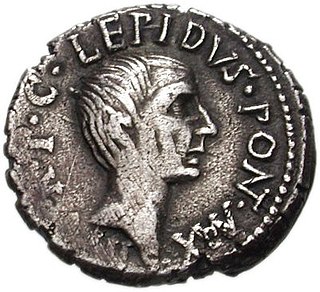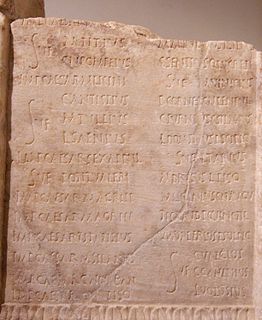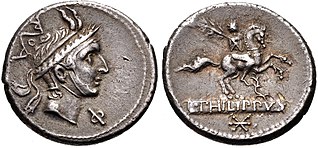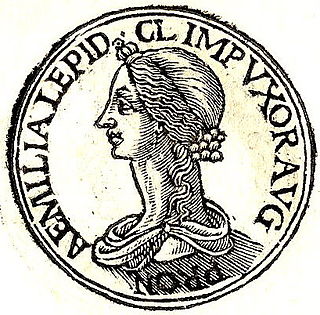Year 43 BC was either a common year starting on Sunday, Monday or Tuesday or a leap year starting on Sunday or Monday of the Julian calendar and a common year starting on Monday of the Proleptic Julian calendar. At the time, it was known as the Year of the Consulship of Pansa and Hirtius. The denomination 43 BC for this year has been used since the early medieval period, when the Anno Domini calendar era became the prevalent method in Europe for naming years.

This article concerns the period 49 BC – 40 BC.

The Second Triumvirate was the political alliance between three of the Roman Republic's most powerful figures: Octavian, Mark Antony, and Lepidus. Formally called the Triumvirate for Organizing the Republic, it was formed on 27 November 43 BC with the enactment of the Lex Titia, and existed for two five-year terms, covering the period until 33 BC. Unlike the earlier First Triumvirate, the Second Triumvirate was an official, legally established institution, whose overwhelming power in the Roman state was given full legal sanction and whose imperium maius outranked that of all other magistrates, including the consuls.

Marcus Aemilius Lepidus was a Roman general and statesman who formed the Second Triumvirate alongside Octavian and Mark Antony during the final years of the Roman Republic. Lepidus had previously been a close ally of Julius Caesar. He was also the last Pontifex Maximus before the Roman Empire.

The gens Aemilia, originally written Aimilia, was one of the greatest patrician families at Rome. The gens was of great antiquity, and claimed descent from Numa Pompilius, the second King of Rome. Its members held the highest offices of the state, from the early decades of the Republic to imperial times. The Aemilii were almost certainly one of the gentes maiores, the most important of the patrician families. Their name was associated with two major roads, an administrative region of Italy, and the Basilica Aemilia at Rome.
Decimus Junius Silanus Torquatus was a Roman senator who lived during the 1st century. He served as an ordinary consul in 53 with Quintus Haterius Antoninus as his colleague. Decimus was the second son born to Aemilia Lepida and Marcus Junius Silanus Torquatus, a member of the Junii Silani, a family of Ancient Rome.
Aemilia Lepida is the name of several ancient Roman women belonging to the gens Aemilia. The name was given to daughters of men belonging to the Lepidus branch of the Aemilius family. The first Aemilia Lepida to be mentioned by Roman historians was the former fiancée of the younger Cato. Subsequent Aemiliae are known because of their marriages.

Lucius Munatius Plancus was a Roman senator, consul in 42 BC, and censor in 22 BC with Lucius Aemilius Lepidus Paullus. Along with Talleyrand eighteen centuries later, he is one of the classic historical examples of men who have managed to survive very dangerous circumstances by constantly shifting their allegiances.

The gens Junia was one of the most celebrated families of ancient Rome. The gens may originally have been patrician, and was already prominent in the last days of the Roman monarchy. Lucius Junius Brutus was the nephew of Lucius Tarquinius Superbus, the seventh and last King of Rome, and on the expulsion of Tarquin in 509 BC, he became one of the first consuls of the Roman Republic.
Marcus Aemilius Lepidus was a Roman statesman and general. After the death of Lucius Cornelius Sulla, he attempted to undermine the Sullan constitution and revive the populares faction. This brought him into conflict with the optimates whom Sulla had put back in power. In 77 BC, when he was recalled from his proconsulship of Gaul, he returned to Rome at the head of an army and an armed conflict erupted. Lepidus' forces were defeated in a battle near the Milvian Bridge and as a result his rebellion failed. He was the father of the triumvir Marcus Aemilius Lepidus and of one of the consuls for 50 BC Lucius Aemilius Lepidus Paullus.

Lucius Marcius Philippus was a Roman orator and an important politician of the late Roman Republic.

Aemilia Lepida was a noble Roman woman and matron. She was the first great-grandchild of the Emperor Augustus.
Marcus Aemilius Lepidus, (6–39) married the emperor Caligula's younger sister Julia Drusilla.
Lucius Cornelius Cinna was the son of the consul Lucius Cornelius Cinna, who was a supporter of politician Gaius Marius. His sister, Cornelia, was the first wife of dictator Julius Caesar and he was the maternal uncle of their daughter Julia Caesaris. Cinna was a member of the illustrious gens Cornelia, who were of patrician status. He was suffect consul in 32 BC.

The gens Porcia, rarely written Portia, was a plebeian family at Ancient Rome. Its members first appear in history during the third century BC. The first of the gens to achieve the consulship was Marcus Porcius Cato in 195 BC, and from then until imperial times, the Porcii regularly occupied the highest offices of the Roman state.

The Philippics are a series of 14 speeches composed by Cicero in 44 and 43 BC, condemning Mark Antony. Cicero likened these speeches to those of Demosthenes against Philip II of Macedon; both Demosthenes’s and Cicero's speeches became known as Philippics. Cicero's Second Philippic is styled after Demosthenes' De Corona.
Marcus Aemilius Lepidus Porcina was a member of the important Roman gens Aemilia, consul of the Roman Republic in 137 BC.

The gens Postumia was an ancient and noble Patrician family at Rome. Throughout the history of the Republic, the Postumii frequently occupied the chief magistracies of the Roman state, beginning with Publius Postumius Tubertus, consul in 505 BC, the fifth year of the Republic. Although like much of the old Roman aristocracy, the Postumii faded for a time into obscurity under the Empire, individuals bearing the name of Postumius again filled a number of important offices from the second century AD to the end of the Western Empire.
The gens Antonia was a Roman family of great antiquity, with both patrician and plebeian branches. The first of the gens to achieve prominence was Titus Antonius Merenda, one of the second group of Decemviri called, in 450 BC, to help draft what became the Law of the Twelve Tables.The most prominent member of the gens was Marcus Antonius.











